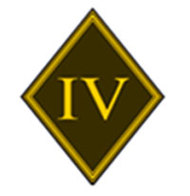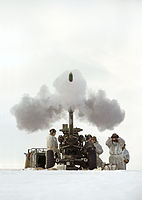
The Royal Regiment of Artillery, commonly referred to as the Royal Artillery (RA) and colloquially known as "The Gunners", is one of two regiments that make up the artillery arm of the British Army. The Royal Regiment of Artillery comprises thirteen Regular Army regiments, the King's Troop Royal Horse Artillery and five Army Reserve regiments.
The 7th Toronto Regiment, Royal Canadian Artillery is a militia regiment of 4th Canadian Division's 32 Canadian Brigade Group,
This is a list of British ground forces in the Falklands War. For a list of ground forces from Argentina, see Argentine ground forces in the Falklands War

The Royal Citadel in Plymouth, Devon, England, was built in the late 1660s to the design of Sir Bernard de Gomme. It is at the eastern end of Plymouth Hoe overlooking Plymouth Sound, and encompasses the site of the earlier fort that had been built in the time of Sir Francis Drake. The citadel site is a Scheduled Monument and many of the buildings within are Grade II Listed.

16 Air Assault Brigade Combat Team, known simply as 16 Air Assault Brigade from 1999 – 2021, is a formation of the British Army predominantly based in Colchester, Essex. It makes up the Air Assault Task Force, a battlegroup held at high readiness, and is the only brigade in the British Army focused on operating via parachute, helicopter and air-landing.

The M119 howitzer is a lightweight 105 mm howitzer, used by the United States Army. It is the American licensed version of the British L119 light gun. The M119 is typically towed by the M1097 or M1152 High Mobility Multi-Purpose Wheeled Vehicle (HMMWV), and can be easily airlifted by helicopter, or airdropped by parachute.

The L118 light gun is a 105 mm towed howitzer. It was originally designed and produced in the United Kingdom for the British Army in the 1970s. It has since been widely exported. The L119 and the United States Army's M119 are variants that use a different type of ammunition.
100 (Yeomanry) Regiment Royal Artillery was part of the Territorial Army and had sub-units throughout the South of England. It had three gun batteries all equipped with the L118 Light Gun. The regiment's original role was British Army of the Rhine (BAOR) emergency reinforcement, emphasised by its transfer into 49 Infantry Brigade under part of 2 Division. Under 'Options for Change', the regiment became a general support unit fitted out with the FH-70 155mm towed howitzer and assigned to 3 Division; in 1999, it was reassigned as a CS Regiment, losing its ability to deploy as a whole unit. Under Army 2020, it was placed in suspended animation.

104 Regiment Royal Artillery is part of the British Army Reserve and has sub-units throughout Wales and the West Midlands of England. It is equipped with the 105mm Light Gun.
148 (Meiktila) Commando Forward Observation Battery is a specialist Naval Gunfire Support Forward Observation (NGSFO) unit within 29 Commando Regiment Royal Artillery of 3 Commando Brigade Royal Marines.
41 Field Battery, Royal Australian Artillery was formally raised in Egypt during March 1916 for service with the 11th Field Artillery Brigade, part of 4th Division Artillery. Today 41st Field Battery is one of 4 batteries that make up the 1st Field Regiment, part of 7 Brigade.
The 43rd Infantry Brigade was a brigade of the British Army during the First and Second World Wars, and later, as 43 (Wessex) Brigade, a regional headquarters from 1985 to 2014.

The 4th Regiment Royal Artillery is a regiment of the Royal Artillery in the British Army. It was formed in 1939 as 4th Regiment Royal Horse Artillery, before being redesignated in 1961.
3rd Regiment Royal Horse Artillery is a regiment of the Royal Horse Artillery in the British Army. They are currently based at Albemarle Barracks, Northumberland, England.
1st Regiment Royal Horse Artillery is a regiment of the Royal Horse Artillery in the British Army. It currently serves in the armoured field artillery role, and is equipped with the AS90 self-propelled gun. The regiment is currently based at Larkhill Garrison, Larkhill. The regiment completed its move from Assaye Barracks, Tidworth, to Larkhill in June 2019.
7th Parachute Regiment, Royal Horse Artillery is a regiment of the Royal Artillery in the British Army. It currently serves in the field artillery role with 16 Air Assault Brigade Combat Team, and is equipped with the L118 Light Gun.
This is the Operation Herrick ground order of battle, which lists any British ground forces that have taken part in the duration of Operation Herrick between 2002 and 2014.

The 1st Artillery Brigade was a support formation of the British Army from 1961-77 and from 1997. Part of the 3rd Division, it oversaw all army close support artillery and deep fires units. Under the Future Soldier programme, the brigade merged with 1st Armoured Infantry Brigade to form 1st Deep Reconnaissance Strike Brigade Combat Team.
The 289 Commando Troop originated as a parachute artillery regiment of the Territorial Army formed in London in 1956. It was transferred to the Royal Horse Artillery in 1960 and reduced to a battery in 1967. In 1977 it was re-roled as a Commando battery before being reduced to a troop in 1999. It is now based in Plymouth as a detached part of 266 Battery where they perform the same Close Support Light Gun Role as part of 104 Regiment Royal Artillery, whilst also supporting 29 Commando Regiment in an unofficial role.

97 Battery Royal Artillery was formed on 13 September 1803 as Captain H. Douglas's Company, 8th Battalion Royal Artillery and is currently a tac battery within 4th Regiment Royal Artillery based in Alanbrooke Barracks, Topcliffe, North Yorkshire. The battery was until recently a gun battery but was reduced to a tactical or tac battery in 2013 following its last operational tour of Afghanistan. It is now one of three tac batteries that call in artillery fire from 4th Regiment Royal Artillery's two remaining gun batteries. The battery has been known by a variety of names during its existence and moved between different Royal Artillery Regiments or Battalions due to reorganisations of the Royal Regiment of Artillery and changes in role. In the First World War it fought as 87th (Howitzer) Battery, Royal Field Artillery.
















